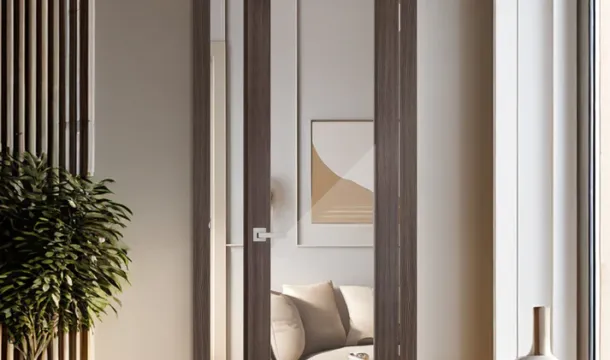Hollow Core vs. Solid Core Interior Doors: What’s the Difference?
Popular Articles
When it comes to choosing interior doors for your home, the options can be overwhelming. Among the most common choices are hollow core and solid core doors. Both have their own advantages and disadvantages, and understanding the differences between them can help you make the best decision for your space. In this article, we will explore the characteristics, benefits, drawbacks, and ideal applications of hollow core and solid core interior doors, helping you choose the right door for your needs.
1. What Are Hollow Core and Solid Core Doors?
Hollow Core Doors
Hollow core doors are lightweight doors that feature a thin veneer of wood or MDF surrounding a honeycomb or cardboard core. Despite their name, these doors are not entirely hollow but have an internal support structure that provides some stability.
-
Construction: Hollow core doors are typically made with a frame of wood or MDF and a core that consists of cardboard or a honeycomb structure. The outer layer is usually a veneer of wood or MDF, giving the appearance of a solid door.
-
Weight: Hollow core doors are much lighter than solid core doors due to their internal structure, which makes them easy to install and handle.
-
Cost: These doors are generally less expensive compared to solid core doors, making them a popular choice for budget-conscious homeowners.
Solid Core Doors
Solid core doors are constructed with a solid material throughout the core, typically made of wood byproducts like MDF or a composite material. These doors are heavier and offer a more substantial feel compared to hollow core doors.
-
Construction: Solid core doors have a solid inner core made of MDF, particleboard, or solid wood, surrounded by a veneer. This construction gives them the appearance of a traditional solid wood door while providing added benefits.
-
Weight: Due to their solid construction, these doors are significantly heavier than hollow core doors, which contributes to their durability and noise-reducing qualities.
-
Cost: Solid core doors are more expensive than hollow core doors, but they offer better quality and performance in return.
2. Key Differences Between Hollow Core and Solid Core Doors
1. Sound Insulation
One of the most significant differences between hollow core and solid core doors is their ability to block sound. Solid core doors provide better sound insulation due to their dense core, making them ideal for rooms where privacy and noise control are important.
-
Hollow Core Doors: These doors provide minimal sound insulation, as the hollow interior allows sound to pass through more easily. They are suitable for rooms where sound control is not a primary concern, such as closets or pantry doors.
-
Solid Core Doors: The dense core of these doors helps to block sound, making them a great choice for bedrooms, bathrooms, home offices, or any other area where privacy and noise reduction are desired.
2. Durability
Durability is another major difference between hollow core and solid core doors. Solid core doors are more robust and can withstand more wear and tear compared to hollow core doors.
-
Hollow Core Doors: These doors are less durable and more prone to damage, such as dents and scratches. Their lightweight construction makes them more susceptible to damage if they are accidentally slammed or hit.
-
Solid Core Doors: Due to their solid construction, these doors are much more durable and resistant to damage. They are less likely to suffer dents or scratches and can handle the everyday use that comes with being installed in high-traffic areas.
3. Weight and Installation
The weight of the door is an important consideration, especially when it comes to installation and ease of use.
-
Hollow Core Doors: These doors are lightweight, making them easy to install and handle. Their lighter weight also means less strain on the hinges and door frame, which can be beneficial for older homes.
-
Solid Core Doors: Solid core doors are heavier, which can make installation more challenging and may require additional support or stronger hinges. However, their weight also gives them a more substantial and high-quality feel.
4. Cost
Cost is often a determining factor for homeowners when choosing interior doors. Hollow core and solid core doors vary significantly in price.
-
Hollow Core Doors: These doors are more affordable, making them an excellent choice for budget-conscious homeowners or for use in areas where durability and sound insulation are not primary concerns.
-
Solid Core Doors: Solid core doors are more expensive but offer greater benefits in terms of sound insulation, durability, and overall quality. They are a worthwhile investment for areas of the home where these factors are important.
5. Aesthetic Appeal
Both hollow core and solid core doors can be visually appealing, but there are some differences in the overall look and feel.
-
Hollow Core Doors: These doors are typically available in a wide range of finishes, including paint and wood veneer. They can look very similar to solid core doors, but they lack the substantial feel of a solid door.
-
Solid Core Doors: These doors have a more substantial appearance and feel, which can add a touch of luxury to your home. The solid construction provides a higher-end look that can elevate the overall aesthetic of your space.
3. Pros and Cons of Hollow Core and Solid Core Doors
Hollow Core Doors
Pros:
-
Affordable and budget-friendly
-
Lightweight and easy to install
-
Available in a variety of finishes
Cons:
-
Poor sound insulation
-
Less durable and more prone to damage
-
Lacks the substantial feel of a solid door
Solid Core Doors
Pros:
-
Excellent sound insulation
-
Durable and resistant to damage
-
High-quality, substantial feel
Cons:
-
More expensive
-
Heavier and more challenging to install
-
May require stronger hardware for support
4. When to Choose Hollow Core vs. Solid Core Doors
The choice between hollow core and solid core doors largely depends on your specific needs, preferences, and budget. Here are some scenarios to help you decide which type of door is best for your home:
Choose Hollow Core Doors If:
-
Budget Is a Priority: If you are looking for an affordable option for your interior doors, hollow core doors are a great choice. They offer a budget-friendly solution without compromising on style.
-
Low-Traffic Areas: Hollow core doors are ideal for areas of the home that do not experience a lot of foot traffic, such as closets, pantry doors, or guest bedrooms.
-
Ease of Installation: If you plan to install the doors yourself or want a lightweight option, hollow core doors are easy to handle and install.
Choose Solid Core Doors If:
-
Sound Insulation Is Important: If you need to block out noise or want privacy, such as in bedrooms, bathrooms, or home offices, solid core doors are the better choice due to their superior sound insulation.
-
Durability Is a Concern: For high-traffic areas, solid core doors are more durable and can withstand everyday wear and tear, making them a better long-term investment.
-
A High-End Look Is Desired: If you want a door that feels substantial and adds a touch of luxury to your space, solid core doors are the way to go.
5. Maintenance and Care Tips for Hollow Core and Solid Core Doors
Proper maintenance can help extend the life of both hollow core and solid core doors. Here are some tips to keep your doors looking and functioning their best:
-
Regular Cleaning: Wipe down the surface of your doors regularly with a damp cloth to remove dust and dirt. Avoid using harsh chemicals, as they can damage the finish.
-
Check Hardware: Periodically check the hinges, handles, and locks to ensure they are secure. Tighten any loose screws to prevent the door from becoming misaligned.
-
Avoid Slamming Doors: Whether you have hollow core or solid core doors, slamming them can cause damage. Encourage family members to close doors gently to prevent wear and tear.
-
Protect from Moisture: Excess moisture can damage both types of doors, particularly hollow core doors. Avoid exposing doors to high humidity levels, and make sure they are properly sealed if used in areas like bathrooms.
Choosing between hollow core and solid core interior doors depends on your specific needs, preferences, and budget. Hollow core doors are lightweight, affordable, and easy to install, making them an excellent choice for low-traffic areas or budget-conscious projects. On the other hand, solid core doors provide superior sound insulation, durability, and a high-quality feel, making them ideal for high-traffic areas or spaces where privacy and noise control are important.
By understanding the differences between these two types of doors, you can make an informed decision that suits your home and lifestyle. Whether you prioritize cost, durability, sound insulation, or aesthetic appeal, there is a door that will meet your needs and enhance the comfort and beauty of your living space.
Popular Articles

Soundproofing Interior Doors: Which Options Are Best for Your Home?

Choosing the Perfect Interior Doors for Your Canadian Home
